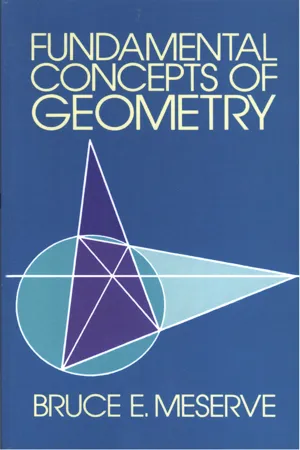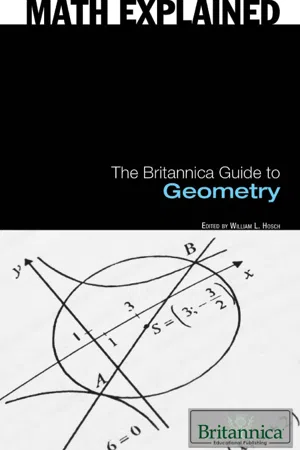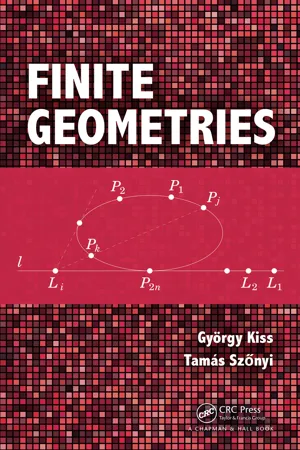Mathematics
Plane Geometry
Plane geometry is a branch of mathematics that focuses on the properties and relationships of two-dimensional shapes, such as points, lines, angles, and polygons, within a flat surface or plane. It involves the study of concepts like distance, area, perimeter, and symmetry, and is fundamental to understanding spatial relationships and solving geometric problems.
Written by Perlego with AI-assistance
Related key terms
4 Key excerpts on "Plane Geometry"
- eBook - ePub
- Bruce E. Meserve(Author)
- 2014(Publication Date)
- Dover Publications(Publisher)
CHAPTER 1 FOUNDATIONS OF GEOMETRY The word “geometry” is derived from the Greek words for “earth measure.” Since the earth was assumed to be flat, early geometers considered measurements of line segments, angles, and other figures on a plane. Gradually, the meaning of “geometry” was extended to include the study of lines and planes in the ordinary space of solids, and the study of spaces based upon systems of coordinates, as in analytic Plane Geometry, where points are represented by sets of numbers (coordinates) and lines by sets of points whose coordinates satisfy linear equations. During the last century, geometry has been still further extended to include the study of abstract spaces in which points, lines, and planes may be represented in many ways. We shall be primarily concerned with the fundamental concepts of the ordinary high-school geometry — euclidean Plane Geometry. Our discussion of these concepts is divided into three parts: the study of the foundations of mathematics (Chapter 1), the development of euclidean Plane Geometry from the assumption of a few fundamental properties of points and lines (Chapters 2 through 6), and a comparison of euclidean Plane Geometry with some other plane geometries (Chapters 7 through 9). The treatment of the second part —the development of euclidean Plane Geometry — forms the core of this text and emphasizes the significance of the assumptions underlying euclidean geometry. Together, the three parts of our study enable us to develop an understanding of and appreciation for many fundamental concepts of geometry. 1–1 Logical systems. We shall consider geometries as logical systems. That is, we shall start with certain elements (points, lines,. . .) and relations (two points determine a line,. . .) and try to deduce the properties of the geometry - eBook - ePub
- Douglas K. Brumbaugh, Peggy L. Moch, MaryE Wilkinson(Authors)
- 2004(Publication Date)
- Routledge(Publisher)
Physical models of geometric planes are everywhere, for example, the surface of a table, wall, or piece of paper. One way to visualize a plane is to use a window glass, because you can see through the surface of the glass, it appears to have no thickness. However, just as a line continues, without end, in opposite directions, a plane continues, without end, in every direction within any two dimensions forms a plane. Just as geometric points, segments, and lines can be represented only by physical models, a geometric plane can be represented only by real-world flat surfaces. You see, a geometric plane is nothing other than a surface; it has absolutely no depth and therefore no visible presence in the physical world. A plane is usually represented by a parallelogram, named with a capital scripted letter, as shown in Fig. 4.8. Fig. 4.8. Your Turn 1. For each of the following, provide a labeled sketch and explain in your own words: a) Point Q b) Line segment ST c) Line k d) Plane R e) Ray UV f) Vector u of length 3 and heading to the right g) Which of these can be measured? 2. Answer each of the following questions and provide a sketch: a) How many different lines could you sketch through a single point? b) How many different lines could you sketch through two points? c) Is it always possible to sketch one line through three points? Angles If two rays that go in different directions are joined so they share their endpoint, the result is an angle. The common endpoint of the two rays is called the vertex of the angle. The rays are called the sides, or legs. Sometimes, for the sake of convenience, line segments are used as sides of an angle, but you should understand that any line segment is a part of a ray. The best way to name an angle is to use three points in order—first a point on one leg, then the vertex point, and then a point on the other leg (the vertex letter is always the middle of the three points defining the angle) - eBook - ePub
- Britannica Educational Publishing, William Hosch(Authors)
- 2010(Publication Date)
- Britannica Educational Publishing(Publisher)
n -gons is still open.Three other unsolved construction problems from antiquity were finally settled in the 19th century by applying tools not available to the Greeks. Comparatively simple algebraic methods showed that it is not possible to trisect an angle with ruler and compass or to construct a cube with a volume double that of a given cube. To show that it is not possible to square a circle (i.e., to construct a square equal in area to a given circle by the same means), however, demanded deeper insights into the nature of the number π.CONIC SECTIONS AND GEOMETRIC ARTThe most advanced part of plane Euclidean geometry is the theory of the conic sections (the ellipse, parabola, and hyperbola). Much as the Elements displaced all other introductions to geometry, the Conics of Apollonius of Perga (c . 240–190 BCE), known by his contemporaries as “The Great Geometer,” was for many centuries the definitive treatise on the subject.Medieval Islamic artists explored ways of using geometric figures for decoration. For example, the decorations of the Alhambra of Granada, Spain, demonstrate an understanding of all 17 of the different “Wallpaper groups” that can be used to tile the plane. In the 20th century, internationally renowned artists such as Josef Albers, Max Bill, and Sol Le Witt were inspired by motifs from Euclidean geometry.SOLID GEOMETRYThe most important difference between plane and solid Euclidean geometry is that human beings can look at the plane “from above,” whereas three-dimensional space cannot be looked at “from outside.” Consequently, intuitive insights are more difficult to obtain for solid geometry than for Plane Geometry.Some concepts, such as proportions and angles, remain unchanged from plane to solid geometry. For other familiar concepts, there exist analogies—most noticeably, volume for area and three-dimensional shapes for two-dimensional shapes (sphere for circle, tetrahedron for triangle, box for rectangle). However, the theory of tetrahedra is not nearly as rich as it is for triangles. Active research in higher-dimensional Euclidean geometry includes convexity and sphere packings and their applications in cryptology and crystallography. - eBook - ePub
- Gyorgy Kiss, Tamas Szonyi(Authors)
- 2019(Publication Date)
- Chapman and Hall/CRC(Publisher)
1 Definition of projective planes, examplesIn this book some familiarity with classical geometry will be assumed. The classical results will not be used explicitly, but will just provide some background motivation for some of the results. Probably everyone has learnt about Euclidean planes. The classical projective plane comes from the classical Euclidean plane by introducing ideal (or infinite) elements. Associated to a parallel class of lines we have an ideal (or infinite) point, and the ideal line (or line at infinity) consists of all the infinite points. The advantage of introducing the classical projective plane is that there is no difference between ordinary and ideal points; two lines always intersect. In classical geometry typical theorems state that under some conditions certain lines pass through a point (for example, if we take a triangle, then the angle bisectors pass through a point) or certain points are on a line. In some cases, the classical theorems use metric properties of the plane (distances and angles), in other cases the order of the points on a line, but there are interesting results that just use incidences of points and lines. A notable example for this is the celebrated Theorem of Desargues.Theorem 1.1.Let A1 A2 A3 and B1 B2 B3 be two triangles in such a position that the lines A{iBipass through a point O. Consider the points, whereA iA j∩B iB j=C ki, j, k} = {1, 2, 3 }. Then the points C1 , C2 , C3 are on a line t.Less formally, when the two triangles are in perspective from the point O then they are also in perspective from the line t. More details on Desargues’ theorem can be found in Coxeter’s book [48 ], where similar theorems, for example the Theorem of Pappus, are also discussed. These theorems will also occur in our book, mainly in the context of finite planes and spaces. In Chapters 2 and 3 we shall see how particular cases of Desargues’ theorem are related to properties of the coordinate structure of the projective plane. We shall also call the configuration of the ten points (A’s, B’s and C’s and O) and the ten lines (the lines AiBi, the sides of the two triangles and the line t) a closed Desargues configuration
Index pages curate the most relevant extracts from our library of academic textbooks. They’ve been created using an in-house natural language model (NLM), each adding context and meaning to key research topics.



